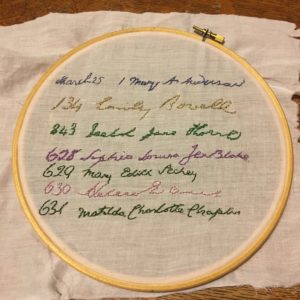I’ve just finished embroidering a piece for my friend Lindy Richardson’s Processions project – a banner which will join us on the Edinburgh Procession on 10 June, to mark 100 years since the first Suffrage Act. Hopefully I’m not too late – like a bad student I’ve got an extension and I’m still working right up to the wire.
Thinking that I needed something I could do quickly and easily (ha ha) I choose to embroider the matriculation register signatures of the Edinburgh Seven. They were the first women to matriculate in a University in the UK. They enrolled at Edinburgh in the hope of becoming doctors, and whilst they were ultimately unsuccessful in graduating from Edinburgh, they were an important first step that paved the way for women to study for and gain degrees in British Universities.
They belong on a suffrage banner because some of them were funded to come to Edinburgh by wealthy ladies who supported the suffrage cause and some of them were directly involved in supporting the suffrage movement. Emily Bovell is particularly dear to my heart (and hence why she’s in gold) as I wrote some of her biography and through some hardcore sleuthing, discovered that she arrived in Edinburgh in 1871* on a scholarship sponsored by Katherine Russell, Vicountess Amberley (mother of Betrand Russell). Katherine Russell is described as an early advocate of birth control, as well as a supporter of women’s suffrage.
Tracing over their signatures in thread has been quite emotional and thought-provoking. Handwriting, and signatures in particular, are very personal and expressive. Following the contours of these ladies’ handwriting I can’t help but think about how they might have felt as they signed their names in the matriculation register. I write in a copperplate hand myself – my script is probably closest to Isabel Thorne’s – and I can see how some of the letters are formed and joined and feel how the script flows. I notice Mary Anderson, (Mary) Edith Pechey and Matilda Chaplin all have the same form of ‘M’. Helen Evan’s signature is a bit of a mess, particularly the capital ‘H’ – sometimes that happens to me too – writing so quickly I drop a letter or mess up the curls on a capital. Sophia Jex Blake, Edith Pechey, Helen Evans and Matilda Chaplin all matriculated together. Their names are in numbered succession in the register and I imagine they must all have stood together as they signed. Mary Anderson was perhaps the only person to matriculate on March 25 since she appears at ‘1’ in the register. I like Matilda Chaplin’s ‘C’s – they drop lower than the rest of her script rather than follow the line in the book which I think has a little flair, and Edith Pechey’s signature is tight and neat and she has a nice curve on her ‘y’s.
My stitching has been done and undone several times. Working on fine muslin was a great idea for tracing the signatures but has sucked in practice for doing the work. It’s too loose a weave and moves too much. I’m finished now though. Please don’t look too closely. I’m actually quite a good embroiderer and my stitching in general is usually quite acceptable. This is not my finest work by a long way.
———-
*1871. It would be another 47 years before any women attained the right to vote, and the 1918 Representation of the People Act only gave women of property over the age of 30 the right to vote. Emily Bovell died in 1885. Edith Pechey died in 1908, Sophia Jex-Blake in 1912.
(Signature, Emily Bovell University of Edinburgh Centre for Research Collections CC-BY 2.0)


One thought on “Tracings (don’t look too closely)”